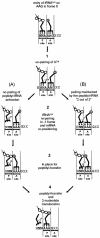Programmed translational -1 frameshifting on hexanucleotide motifs and the wobble properties of tRNAs
- PMID: 12970189
- PMCID: PMC212731
- DOI: 10.1093/emboj/cdg465
Programmed translational -1 frameshifting on hexanucleotide motifs and the wobble properties of tRNAs
Abstract
Programmed -1 ribosomal frameshifting, involving tRNA re-pairing from an AAG codon to an AAA codon, has been reported to occur at the sequences CGA AAG and CAA AAG. In this study, using the recoding region of insertion sequence IS3, we have investigated the influence on frameshifting in Escherichia coli of the first codon of this type of motif by changing it to all other NNA codons. Two classes of NNA codons were distinguished, depending on whether they favor or limit frameshifting. Their degree of shiftiness is correlated with wobble propensity, and base 34 modification, of their decoding tRNAs. A more flexible anticodon loop very likely makes the tRNAs with extended wobble more prone to liberate the third codon base, A, for re-pairing of tRNALys in the -1 frame.
Figures





Similar articles
-
Sequence requirements for efficient translational frameshifting in the Escherichia coli dnaX gene and the role of an unstable interaction between tRNA(Lys) and an AAG lysine codon.Genes Dev. 1992 Mar;6(3):511-9. doi: 10.1101/gad.6.3.511. Genes Dev. 1992. PMID: 1547945
-
Expression of a coronavirus ribosomal frameshift signal in Escherichia coli: influence of tRNA anticodon modification on frameshifting.J Mol Biol. 1997 Jul 18;270(3):360-73. doi: 10.1006/jmbi.1997.1134. J Mol Biol. 1997. PMID: 9237903 Free PMC article.
-
Influence of the stacking potential of the base 3' of tandem shift codons on -1 ribosomal frameshifting used for gene expression.RNA. 2002 Jan;8(1):16-28. doi: 10.1017/s1355838202012086. RNA. 2002. PMID: 11871658 Free PMC article.
-
Decoding the genome: a modified view.Nucleic Acids Res. 2004 Jan 9;32(1):223-38. doi: 10.1093/nar/gkh185. Print 2004. Nucleic Acids Res. 2004. PMID: 14715921 Free PMC article. Review.
-
Bacterial wobble modifications of NNA-decoding tRNAs.IUBMB Life. 2019 Aug;71(8):1158-1166. doi: 10.1002/iub.2120. Epub 2019 Jul 8. IUBMB Life. 2019. PMID: 31283100 Free PMC article. Review.
Cited by
-
mRNA and tRNA modification states influence ribosome speed and frame maintenance during poly(lysine) peptide synthesis.J Biol Chem. 2022 Jun;298(6):102039. doi: 10.1016/j.jbc.2022.102039. Epub 2022 May 17. J Biol Chem. 2022. PMID: 35595100 Free PMC article.
-
The interplay of mRNA stimulatory signals required for AUU-mediated initiation and programmed -1 ribosomal frameshifting in decoding of transposable element IS911.J Bacteriol. 2011 Jun;193(11):2735-44. doi: 10.1128/JB.00115-11. Epub 2011 Apr 8. J Bacteriol. 2011. PMID: 21478364 Free PMC article.
-
Functional analysis of insertion sequence ISAba1, responsible for genomic plasticity of Acinetobacter baumannii.J Bacteriol. 2009 Apr;191(7):2414-8. doi: 10.1128/JB.01258-08. Epub 2009 Jan 9. J Bacteriol. 2009. PMID: 19136598 Free PMC article.
-
An extended signal involved in eukaryotic -1 frameshifting operates through modification of the E site tRNA.Mol Cell. 2005 Jan 7;17(1):61-8. doi: 10.1016/j.molcel.2004.12.009. Mol Cell. 2005. PMID: 15629717 Free PMC article.
-
-1 frameshifting at a CGA AAG hexanucleotide site is required for transposition of insertion sequence IS1222.J Bacteriol. 2004 May;186(10):3274-7. doi: 10.1128/JB.186.10.3274-3277.2004. J Bacteriol. 2004. PMID: 15126494 Free PMC article.
References
-
- Atkins J.F. and Gesteland,R.F. (1995) Discontinuous triplet decoding with or without re-pairing by peptidyl tRNA. In Söll,D. and RajBhandary,U.L. (eds), tRNA: Structure, Biosynthesis and Function. ASM Press, Washington, DC, pp. 471–490.
-
- Atkins J.F., Herr,A., Massire,C., O’Connor,M., Ivanov,I. and Gesteland,R.F. (2000) Poking a hole in the sanctity of the triplet code: inferences for framing. In Garrett,R.A., Douthwaite,S.R., Liljas,A., Matheson,A.T., Moore,P.B. and Noller,H.F. (eds), The Ribosome: Structure, Function, Antibiotics and Cellular Interactions. ASM Press, Washington, DC, pp. 369–383.
-
- Atkins J.F. et al. (2001) Over-riding standard decoding: implication of recoding for ribosome function and enrichment of gene expression. In Cold Spring Harbor Symposium on Quantitative Biology, Vol. LXVI, The Ribosome. Cold Spring Harbor Laboratory Press, Cold Spring Harbor, NY, pp. 217–232. - PubMed
-
- Björk G.R. (1995) Biosynthesis and function of modified nucleosides in tRNA. In Söll,D. and RajBhandary,U.L. (eds), tRNA: Structure, Biosynthesis and Function. ASM Press, Washington, DC, pp. 165–205.
Publication types
MeSH terms
Substances
Grants and funding
LinkOut - more resources
Full Text Sources
Molecular Biology Databases
Research Materials

